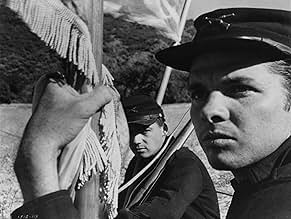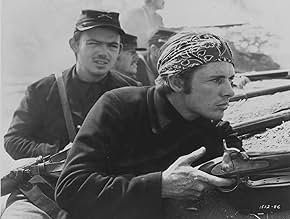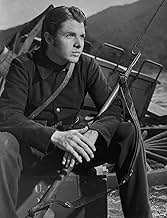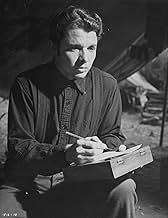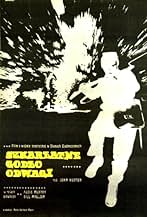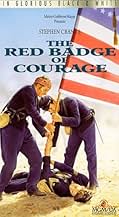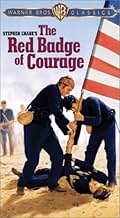CALIFICACIÓN DE IMDb
7.1/10
5.2 k
TU CALIFICACIÓN
Un joven recluta norteamericano se enfrenta al horror de la guerra de Secesión, debatiéndose entre sus ganas de luchar y las dudas sobre su propio coraje.Un joven recluta norteamericano se enfrenta al horror de la guerra de Secesión, debatiéndose entre sus ganas de luchar y las dudas sobre su propio coraje.Un joven recluta norteamericano se enfrenta al horror de la guerra de Secesión, debatiéndose entre sus ganas de luchar y las dudas sobre su propio coraje.
- Dirección
- Guionistas
- Elenco
- Nominada a1 premio BAFTA
- 2 premios ganados y 1 nominación en total
Robert Easton
- Thompson
- (as Robert Easton Burke)
Don Anderson
- Soldier
- (sin créditos)
Smith Ballew
- Union Captain
- (sin créditos)
Albert Band
- Union Soldier Fording River
- (sin créditos)
Gregg Barton
- Soldier
- (sin créditos)
Whit Bissell
- Wounded Officer
- (sin créditos)
Robert Board
- Soldier
- (sin créditos)
Chet Brandenburg
- Wounded Soldier
- (sin créditos)
Edwin Breen
- Confederate Flag Bearer
- (sin créditos)
Joe Brown Jr.
- Soldier
- (sin créditos)
- Dirección
- Guionistas
- Todo el elenco y el equipo
- Producción, taquilla y más en IMDbPro
Opiniones destacadas
Although John Huston's The Red Badge of Courage has stood the test of time critically, back then it lost lots of money in its first release. The film was a bone of contention between Louis B. Mayer and Dore Schary who were locked in a power struggle for control at Metro-Goldwyn- Mayer. Schary wanted to make the film, Mayer said it would flop and he was proved right. He also got ousted anyway.
The Red Badge of Courage refers to the blood that gets spilled should you sustain a battle wound. If you remember in Oliver Stone's Platoon, the men don't treat new arrival Charlie Sheen until he's gotten one of those. Here the Red Badge is something to be avoided if possible.
By a piece of serendipity when Audie Murphy returned from World War II and was deciding on a career, he chose the movies. He certainly was loaded down with offers, but I guess he sensed in himself an inner gift for being an actor. Not Marlon Brando or Laurence Olivier, but someone in the hands of the right director could get a good performance out of him. In John Huston he found that director, twice in fact as he later worked with him in The Unforgiven.
There was no need for research because our most decorated soldier in history lived the research in North Africa and Europe. There's a dimension to Audie's performance and that of GI cartoonist Willard Mullin that no training at the Actor's Studio could have given them. Murphy just summoned his memories of what it was like to be a kid from Texas whisked off to Europe the way young Henry Fleming is facing the Confederates in their backyard.
Murphy gets good support from an able cast of people like Arthur Hunnicutt, Royal Dano, John Dierkes, and Andy Devine as various other soldiers in the Union Army, all citizens serving their country. No career people in this crowd. Also James Whitmore, reading the narrative of Stephen Crane's novel serves almost like another cast member and moves the film's story line along.
Though it lost money for MGM, The Red Badge of Courage is still a fine film with some great insights into the meaning of battlefield bravery.
The Red Badge of Courage refers to the blood that gets spilled should you sustain a battle wound. If you remember in Oliver Stone's Platoon, the men don't treat new arrival Charlie Sheen until he's gotten one of those. Here the Red Badge is something to be avoided if possible.
By a piece of serendipity when Audie Murphy returned from World War II and was deciding on a career, he chose the movies. He certainly was loaded down with offers, but I guess he sensed in himself an inner gift for being an actor. Not Marlon Brando or Laurence Olivier, but someone in the hands of the right director could get a good performance out of him. In John Huston he found that director, twice in fact as he later worked with him in The Unforgiven.
There was no need for research because our most decorated soldier in history lived the research in North Africa and Europe. There's a dimension to Audie's performance and that of GI cartoonist Willard Mullin that no training at the Actor's Studio could have given them. Murphy just summoned his memories of what it was like to be a kid from Texas whisked off to Europe the way young Henry Fleming is facing the Confederates in their backyard.
Murphy gets good support from an able cast of people like Arthur Hunnicutt, Royal Dano, John Dierkes, and Andy Devine as various other soldiers in the Union Army, all citizens serving their country. No career people in this crowd. Also James Whitmore, reading the narrative of Stephen Crane's novel serves almost like another cast member and moves the film's story line along.
Though it lost money for MGM, The Red Badge of Courage is still a fine film with some great insights into the meaning of battlefield bravery.
The original cut of THE RED BADGE OF COURAGE has never been seen--and probably does not exist--but this is the truncated version of the John Huston film and it's still powerful stuff.
It's an examination of courage among men under intense fire--such as the infantry men in the Civil War, about whom writer Stephen Crane wrote with almost poetical finesse. So that some of Crane's writing is maintained on screen, we get a narration by James Whitmore that succeeds in helping us understand the central character (AUDIE MURPHY) and his motivations.
Judging from photographs of the Civil War, the film has a gritty, realistic look as it goes from battle to battle with a group of men we get to know and recognize as vulnerable human beings caught in the tragedy of impossible battle situations.
AUDIE MURPHY is not noted for being an actor capable of deep characterization, but he's been guided by Huston to give a very effective, deeply felt performance, no doubt helped by the fact that he's been in the midst of battle before (he's a real life war hero), and must know the inner conflicts that face any man in battle.
The supporting cast of actors are fine, especially BILL MAULDIN as Audie's friend, both of them confessing moments of cowardice during battle fatigue and then able to go on with their mission.
But the real credit has to go to John Huston for writing and directing a film that he was never especially proud of, but which is stunningly photographed and directed with great skill.
It's an examination of courage among men under intense fire--such as the infantry men in the Civil War, about whom writer Stephen Crane wrote with almost poetical finesse. So that some of Crane's writing is maintained on screen, we get a narration by James Whitmore that succeeds in helping us understand the central character (AUDIE MURPHY) and his motivations.
Judging from photographs of the Civil War, the film has a gritty, realistic look as it goes from battle to battle with a group of men we get to know and recognize as vulnerable human beings caught in the tragedy of impossible battle situations.
AUDIE MURPHY is not noted for being an actor capable of deep characterization, but he's been guided by Huston to give a very effective, deeply felt performance, no doubt helped by the fact that he's been in the midst of battle before (he's a real life war hero), and must know the inner conflicts that face any man in battle.
The supporting cast of actors are fine, especially BILL MAULDIN as Audie's friend, both of them confessing moments of cowardice during battle fatigue and then able to go on with their mission.
But the real credit has to go to John Huston for writing and directing a film that he was never especially proud of, but which is stunningly photographed and directed with great skill.
This is really a very fine film and after seeing it on has to wonder why Audie Murphy never had more substantial roles in his career, as he was quite good in this film. As was mentioned in a previous post he was playing himself in the movie To Hell and Back and was essentially a B-Western actor the remainder of his career. This films shows that he was much more talented than one would ever know from watching the bulk of his films.
stephen crane's best work. audie murphy's best work. any serious student of the civil war will recognize this film as the best, most honest portrayal of civil war action. it captures the fear and dread of deadly combat like no other film on the american civil war. during bloody battles, if your side was not having a successful day, the usual way out was "skedaddling" or running like the wind. both sides did it. a great little film that all civil war students and scholars should own and view every so often.
I can't understand why this movie isn't more well known or why it doesn't get more critical applause. Well, I suppose it's in black and white, it's short, it has no expensive bankable stars, and no love interest. I can't think of any other reasons, because this is a very good movie indeed. John Huston's direction is outstanding, while still being understated. When he was uninterested, Huston could do a merely pedestrian job. But he must have been interested in "The Red Badge of Courage," from beginning to end.
Example from the beginning: a group of soldiers are gathered around a speaker who is spreading rumors about a coming battle, most of their backs turned to us. The camera slowly moves in towards the small crowd, not the speaker, but the backs of the listeners' heads, and one of the soldiers turns around towards the camera and steps quickly into a close up with an expression of deep self-doubt. What a way to introduce Audie Murphy as Henry Fleming! What a way to individuate a mob of naive young men!
Example from the end: Henry and his friend Tom, played by Bill Mauldin, are marching away from the battlefield, still alive, and a bit surprised. Tom says something about how the birds are beginning to sing again, and Henry agrees that as soon as the smoke and noise of battle end it doesn't take the birds long to get worked up again. Henry looks upward over his shoulder, and Huston gives us a point-of-view shot of a hazy sun drifting dimly through the tops of the trees that tower alongside the road. The cast could hardly do better. It is Audie Murphy's best performance by far. In "To Hell and Back," in which he played himself, he wasn't required to do much more than rudimentary acting, and the film itself is cliché ridden. Here, Murphy convinces us that he's worried, or scared, or hijacked by his amygdala, or whatever the situation calls for. His boyish voice is completely appropriate to the role, as is his overall appearance. He seems to have really given this movie some effort. Bill Mauldin as Tom is also surprisingly good. He was undoubtedly the most famous and most controversial cartoonist of World War II and spent a good deal of time with Murphy's Third Division in Italy. He may not be a trained actor, but his sincerity, his gawky face and outlandish ears are more convincing than, say, Tab Hunter's brawn ever was. All of the supporting cast are excellent, particularly John Dierkes as the dying soldier.
Do you want to have your hair raised? Read Steven Crane's original novel. He was 22 when he wrote it, years after the Civil War had ended, but no one would know it from the novel, which has the ring of reminiscence about it. The scene of the dying soldier as he actually dies, standing and trembling from head to foot as if in some Jacksonian fit, is unforgettable in its horror. It's impossible to identify the battle on which the book was based, if indeed there was any.
Let's face facts. The North lost damned near all of its most dramatic battles, and not through the fault of its soldiers or junior officers. (General Winterside's cognomen must have been influenced by the real-life General Ambrose Burnside, for whom our "sideburns" are named. Burnside was one of Lincoln's worst generals and had the good sense and the courage to admit it himself.} The Penninsular campaign, fought under MacLellan, another real hard-charging fire eater, was a dismal failure and ended in an ignominious retreat Crane was from New Jersey and is now buried in Evergreen Cemetery in Hillside, having died a young man. One can only wonder what he might have accomplished had he written more than just two novels. The photography may be black and white but it's splendidly done. I find the only two problems, and they're relatively minor ones, involve the production itself. This isn't back East where the war was fought. This is clearly California, with scattered live oak trees dark and evergreen against the dried summer bunch grass. And the musical score is generic, adding little to the picture aside from the expected Battle Hymn of the Republic and triumphant marches in major keys. A fine picture, all around.
Example from the beginning: a group of soldiers are gathered around a speaker who is spreading rumors about a coming battle, most of their backs turned to us. The camera slowly moves in towards the small crowd, not the speaker, but the backs of the listeners' heads, and one of the soldiers turns around towards the camera and steps quickly into a close up with an expression of deep self-doubt. What a way to introduce Audie Murphy as Henry Fleming! What a way to individuate a mob of naive young men!
Example from the end: Henry and his friend Tom, played by Bill Mauldin, are marching away from the battlefield, still alive, and a bit surprised. Tom says something about how the birds are beginning to sing again, and Henry agrees that as soon as the smoke and noise of battle end it doesn't take the birds long to get worked up again. Henry looks upward over his shoulder, and Huston gives us a point-of-view shot of a hazy sun drifting dimly through the tops of the trees that tower alongside the road. The cast could hardly do better. It is Audie Murphy's best performance by far. In "To Hell and Back," in which he played himself, he wasn't required to do much more than rudimentary acting, and the film itself is cliché ridden. Here, Murphy convinces us that he's worried, or scared, or hijacked by his amygdala, or whatever the situation calls for. His boyish voice is completely appropriate to the role, as is his overall appearance. He seems to have really given this movie some effort. Bill Mauldin as Tom is also surprisingly good. He was undoubtedly the most famous and most controversial cartoonist of World War II and spent a good deal of time with Murphy's Third Division in Italy. He may not be a trained actor, but his sincerity, his gawky face and outlandish ears are more convincing than, say, Tab Hunter's brawn ever was. All of the supporting cast are excellent, particularly John Dierkes as the dying soldier.
Do you want to have your hair raised? Read Steven Crane's original novel. He was 22 when he wrote it, years after the Civil War had ended, but no one would know it from the novel, which has the ring of reminiscence about it. The scene of the dying soldier as he actually dies, standing and trembling from head to foot as if in some Jacksonian fit, is unforgettable in its horror. It's impossible to identify the battle on which the book was based, if indeed there was any.
Let's face facts. The North lost damned near all of its most dramatic battles, and not through the fault of its soldiers or junior officers. (General Winterside's cognomen must have been influenced by the real-life General Ambrose Burnside, for whom our "sideburns" are named. Burnside was one of Lincoln's worst generals and had the good sense and the courage to admit it himself.} The Penninsular campaign, fought under MacLellan, another real hard-charging fire eater, was a dismal failure and ended in an ignominious retreat Crane was from New Jersey and is now buried in Evergreen Cemetery in Hillside, having died a young man. One can only wonder what he might have accomplished had he written more than just two novels. The photography may be black and white but it's splendidly done. I find the only two problems, and they're relatively minor ones, involve the production itself. This isn't back East where the war was fought. This is clearly California, with scattered live oak trees dark and evergreen against the dried summer bunch grass. And the musical score is generic, adding little to the picture aside from the expected Battle Hymn of the Republic and triumphant marches in major keys. A fine picture, all around.
¿Sabías que…?
- TriviaAfter seeing what MGM had done to the film, John Huston instructed his agent to include a clause in all future contracts guaranteeing that he would receive a copy of his director's cut on all of his films.
- ErroresBeginning at 14:28, several Union soldiers wading across the waist-deep river and later climbing out of the river are carrying the U.S. Rifle Model 1903, also known as the Springfield Model 1903. Note especially the soldier who climbs out of the river holding his rifle above his head. The Model 1903 is a bolt-action, magazine-fed rifle that was adopted by the US Army in 1903 and used in World Wars I and II, but not the American Civil War which was fought from 1861-1865.
- Citas
The General: Howdy Jim, Corporal. How are those wounds?
Soldier: Stinging some, General, but they're a-mending.
The General: That's fine, fine. Anybody care for a chaw?
- ConexionesEdited into Hollywood: The Dream Factory (1972)
Selecciones populares
Inicia sesión para calificar y agrega a la lista de videos para obtener recomendaciones personalizadas
- How long is The Red Badge of Courage?Con tecnología de Alexa
Detalles
Taquilla
- Presupuesto
- USD 1,640,000 (estimado)
- Tiempo de ejecución
- 1h 9min(69 min)
- Color
- Relación de aspecto
- 1.37 : 1
Contribuir a esta página
Sugiere una edición o agrega el contenido que falta


